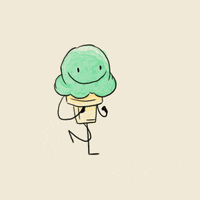
Technology, migration and explorations have tremendously changed what we eat. The story of the evolution of ice cream is one such story.
Ice cream is one of the most wonderful human creations. Today, ice cream is a $66 bn industry, and is still growing. But when it started spreading around the world, it wasn’t meant for everyone to consume.
It was considered a royalty, until some enterprising individuals decided to make it available for the masses, very much similar to the history of sugar.
So, what does the history of ice cream look like? And how exactly did they make ice cream before refrigerators existed?

The origins of ice cream
Like almost every other food on the planet, there is no single person who invented ice cream. However, we see that back in 200 B.C., people in China had started creating a dish of rice and milk, which they froze by packing in snow.
Tadaa – the earliest variant of ice cream was born. How they arrived at this combination seems like a result of a lot of hit and trial. Most food we eat today has evolved over decades, if not centuries. Ice cream is no different in that regard.
The Chinese kings started filling pots with milk and syrups, and placing them in the snow in order to freeze them.
It is also known that the rulers around this time indulged in desserts of snow. Alexander the Great enjoyed eating snow flavoured with honey.
But, these desserts were restricted to the royalty. Ice cream was not a widely known product yet.
Spreading across the world
And then came the time of the European explorers. Some sources suggest Marco Polo brought back ice cream recipes from China to Italy. However, this could be a made-up story.
Nevertheless, the point being, ice cream travelled to Europe, where it became a desert for the royalty. These royal people frequently hosted other kings and queens, and with a thing like ice cream, it was obvious that things would spread!
And yet, it is alleged that some of the royalty tried to keep the ice cream recipe a secret!
But good things eventually spread in the world. And so did ice cream. Cafe Procope in France started serving Ice Cream to the general public in the late 17th century. They made this ice cream using milk, cream, butter and eggs.
And then, ice cream arrived in America. The earliest known mention of Ice Cream in America is in 1744. And the American elite loved the delicacy. President George Washington is known to have spent $200 (about $3000 today) in 1790 alone on Ice Cream!
Then America, being America, started commercializing the product like anything.
However, there was still a big problem. Refrigerators didn’t exist. So production was slow, and consumption had to be quick, otherwise:

This changed when in 1870, Germany invented industrial refrigeration. And it had a catalytic effect on the industry. Then came the invention of cones, hundreds of flavours and varieties of ice creams, and so on.
Long live ice creams!
In another part of the world
Europe and America were not the only places where ice-cream was created and consumed. In the 16th century, “kulfi” started becoming popular in India.
The word Kulfi is derived from Farsi. Kulfi means “covered up”. Flavoured with pistachios, saffron, and other dry fruits, Kulfi was usually surved in small matkas which would allow it to be stored for longer and prevent it from melting.
But in India, especially in Delhi, where the rulers had their capital, there was no snow to freeze ice cream. So how did they make ice cream in the sweltering Delhi heat? Some sources suggest they transported Himalayan ice to warmer regions, but I don’t believe that would have been enough.
But they knew how to freeze ice cream.
Okay, back to chemistry. How is ice cream frozen?
The basic idea of how ice cream has remained the same over the years.
You fill up a bucket full of ice, then place a pot of cream, sugar and whatever flavour of ice cream you want. Then you add some salt to the ice. Let the magic happen!
What actually happens in this process?
Salt, as you might know, lowers the freezing temperature of ice. This is also the reason why salt is poured over snow-covered streets in the winter.

Now, because the freezing point of ice is lowered, it needs energy to melt.
And where does it get that energy from? Surprise, surprise! From our pot sitting in the middle. It starts sucking out the heat from the pot, resulting in the pot and its content cooling down (and freezing) while the ice outside starts melting – however, the melting is very slow.
And you can use this same process to make more ice, so once you have some supply of ice, you can continue to make ice and ice cream.
This principle was the primary way in which ice cream was made, until the advent of refrigerators.
Earlier on, “saltpeter” was used instead of salt to freeze Kulfi. At the time, saltpeter was used for making fireworks and gunpowder. It is likely that someone stumbled upon its freezing properties.
- The History of Ice Cream (todayifoundout.com)
- The story of Kulfi – STORY OF THE KULFI (kesarsweets.com)
- Saltpeter for making ice cream – How Did They Make Ice Cream in the 17th Century? (gizmodo.com)
If you liked reading this essay, do subscribe to my newsletter, Magnifier, where I share such essays every week: